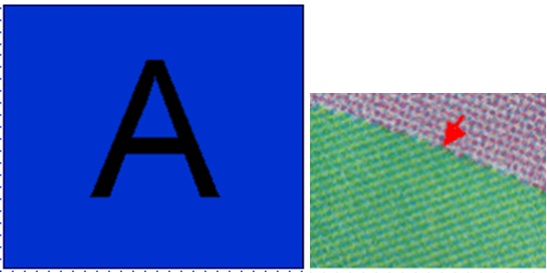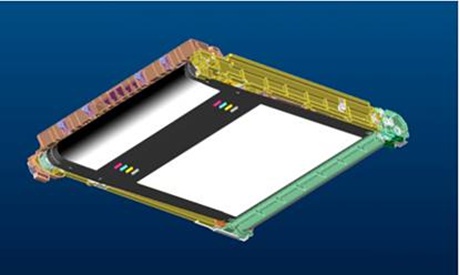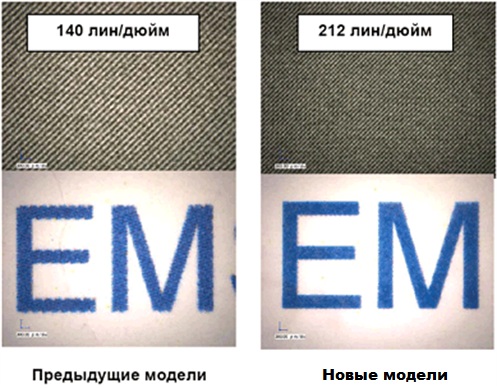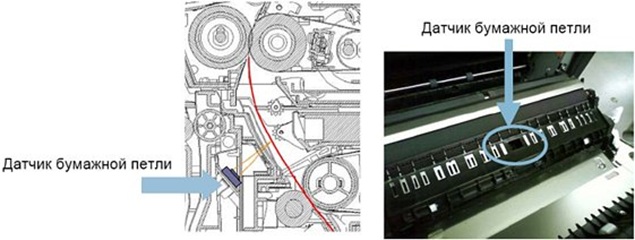Innovation KYOCERA (Part 2)
We propose to continue the discussion on the possibilities and design solutions applied by KYOCERA in the new MFP series.
Trapping function
In the new series of MFPs, the quality of the printed image has been improved by compensating the controller of the gap apparatus that occurs when printing text over background color fills.
')

This gap between the colors is compensated by a barely noticeable overlay of the background color on the edge of the text.

This technology was called "trapping" and began to be used in operational printing to produce prints of professional quality. MFP new series uses this technology to improve the print quality of the image as a standard when printing black text.
In this case, the print driver allows, if necessary, to control the amount of trapping, providing 5 levels of color trapping:
Off (no overlap);
Light (overlay 0.5 pixels wide);
Medium (1 pixel wide);
Heavy (overlapping 1.5 pixels wide);
Very heavy (2 pixels wide overlay).
Intelligent Calibration
Any full-color MFP requires regular calibration procedures in order to maintain high quality images. This need is dictated by the significant influence of the environment and the characteristics of the MFP itself on the parameters for the formation of a full-color image. That is why during the printing or copying of large print runs the MFP suspends work for a while and asks to wait.
The KYOCERA developers managed to circumvent such a decrease in the productivity of the devices by using the technology of intelligent calibration, which is that during the operation of the MFP, rapid calibration is performed. For this, the time gap and the space that exists between the sheets following one another is enough. The image below shows the position of the self-calibration labels on the transfer belt of the multifunction printer with respect to the two copied images.

High lineature
As is known, the optical resolution of the MFP print unit is of exceptional importance for the realization of high-quality images of a copy or print. In most modern full-color multifunction printers, the optical resolution of the printing mechanism is 600 dpi or dots per inch. From this point of view, the new series of full-color MFPs is no exception (although the algorithmic print resolution can reach the value of 9600 x 600 dpi). But there is one more characteristic of the print unit, which, as a rule, MFP manufacturers are silent about. This characteristic has received the name "LINEATURA" (measured in lines per inch). If the resolution value characterizes the size of the element of the reproduced image (point), then the magnitude of the linearature indicates how far these elements of the image are separated from each other. Accordingly, the higher the lineature, the higher the image quality.
In full-color MFPs of the new series, the value of the lineature, as compared with the previous series, was increased by one and a half times, which significantly improved the quality of the resulting image. This is remarkably seen in the illustrations below.

Color Optimizer (plugin for KX ver.5.0 print driver)
Now, when performing full-color printing on the MFP of a new series using the KX ver.5.0 print driver, the user can use the Color Optimizer plug-in to achieve accurate color reproduction by selecting the desired color from the standard color palette.
The use of parts and components with high resource
As part of the new full-color MFPs, as in the full-color MFPs of the previous series, technologies are used to ensure a long service life, both individual parts and entire assemblies. These technologies are the "highlight" of KYOCERA multi-functional equipment and the result of many years of research and development of the company's developers.
According to the already established tradition of the company KYOCERA, photo-drums with photoreceptor coating of amorphous silicon are used in blocks of image formation of new full-color multifunction printers. This photoreceptor material provides a combination of high performance properties and long service life. That is why in the new models of full-color MFPs, it became possible to extend the maintenance period to 300 thousand copies / prints of A4 size. This means that during operation, devices in this series will be less idle due to maintenance and will require less capital investment.
New intermediate transfer belt and new separation system
When performing black and white copying or printing, the intermediate transfer belt is automatically retracted from the three color imaging units. At the same time, the development shafts and photodrums of these blocks stop rotating. This significantly increases the service life of color blocks forming the image.

Another significant advantage of such a mechanism for retracting / feeding an intermediate transfer belt is that in the case of the end of the color toner in the MFP, the user will be able to continue black-and-white copying or printing.
Swivel copy / print guide
Thanks to the use of new technologies in new-color MFPs, it has become possible to increase the range of paper weights used. Now in the front paper feed trays and in the duplex, you can use paper with a density of 163 g / m2 (confident double-sided full-color printing on paper with a density of up to 300 g / m2 is possible).
This was made possible through the use of a turning guide, the angle of rotation of which depends on the type of paper currently being used. If in the previous models of full-color MFPs, the position of the guide was changed due to the electromagnet triggering, then the new series uses a guide assembly rotated by a servo motor, which significantly reduced the curvature of a sheet of paper as it moves along the path of the MFP.
Paper loop sensor
Unlike the previous series of full-color MFPs, in the apparatus of the new series, the rotational speed of the thermoblock shafts is determined by the feedback signal received from the paper loop sensor.

The sensor monitors whether the paper passes along the transport guide or it moves away from it, forming a paper loop. This technology allows to reduce the likelihood of wrinkles on sheets of paper.
Energy efficient microprocessor
The control system of new full-color multifunction printers built on the basis of an energy-efficient microprocessor. This microprocessor every 15 minutes receives information about temperature and humidity, monitors the current state of the MFP and the environment in the room. Thanks to the incoming information, the microprocessor of the MFP of the new series more correctly manages the conditioning of the photoconductors, calibration at the exit from the sleep mode and the heating of the photodrums. Thus, if there is no need, the calibration of the multifunction printer after the release from the sleep mode, as well as the conditioning of the photo drums in conditions of high humidity of the environment, may not be performed, or it may be performed according to a shortened program. All this allows not only to minimize the cost of electricity and time, but also, of course, can significantly reduce unproductive consumption of toner.
Automatic diagnostics system
KYOCERA's new full-color MFPs have built-in automatic diagnostics of the print environment, which defines the main way users use the MFP. For example, once having determined the color utilization factor, image fill factor, average print volume, and other parameters, the MFP optimizes the settings for automatic color mode selection, color calibration frequency, the function of removing intermediate transfer ribbon from color photoconductors, and so on. All of this is designed to achieve the best fit for users and maximally simplify the day-to-day operation of the MFP by end users

New cooling system
In high-performance apparatuses (not only KYOCERA production), the design of the MFP includes a cooling system, the task of which is to compensate for the sharp rise in temperature inside the apparatus when performing large volumes of work. Unlike the full-color MFPs of the previous series, the advanced cooling system is used in the new series, which includes air ducts and flexible cooling tubes.

The system allows for quick and efficient cooling of the apparatus design. Thus, for efficient cooling of the contact area of the toner and the development unit, the MFP uses a metal plate and an air duct, which allows the toner particles to maintain their electrophysical characteristics constant, even with large volumes of copying or printing and high performance of the MFP.
Trapping function
In the new series of MFPs, the quality of the printed image has been improved by compensating the controller of the gap apparatus that occurs when printing text over background color fills.
')

This gap between the colors is compensated by a barely noticeable overlay of the background color on the edge of the text.

This technology was called "trapping" and began to be used in operational printing to produce prints of professional quality. MFP new series uses this technology to improve the print quality of the image as a standard when printing black text.
In this case, the print driver allows, if necessary, to control the amount of trapping, providing 5 levels of color trapping:
Off (no overlap);
Light (overlay 0.5 pixels wide);
Medium (1 pixel wide);
Heavy (overlapping 1.5 pixels wide);
Very heavy (2 pixels wide overlay).
Intelligent Calibration
Any full-color MFP requires regular calibration procedures in order to maintain high quality images. This need is dictated by the significant influence of the environment and the characteristics of the MFP itself on the parameters for the formation of a full-color image. That is why during the printing or copying of large print runs the MFP suspends work for a while and asks to wait.
The KYOCERA developers managed to circumvent such a decrease in the productivity of the devices by using the technology of intelligent calibration, which is that during the operation of the MFP, rapid calibration is performed. For this, the time gap and the space that exists between the sheets following one another is enough. The image below shows the position of the self-calibration labels on the transfer belt of the multifunction printer with respect to the two copied images.

High lineature
As is known, the optical resolution of the MFP print unit is of exceptional importance for the realization of high-quality images of a copy or print. In most modern full-color multifunction printers, the optical resolution of the printing mechanism is 600 dpi or dots per inch. From this point of view, the new series of full-color MFPs is no exception (although the algorithmic print resolution can reach the value of 9600 x 600 dpi). But there is one more characteristic of the print unit, which, as a rule, MFP manufacturers are silent about. This characteristic has received the name "LINEATURA" (measured in lines per inch). If the resolution value characterizes the size of the element of the reproduced image (point), then the magnitude of the linearature indicates how far these elements of the image are separated from each other. Accordingly, the higher the lineature, the higher the image quality.
In full-color MFPs of the new series, the value of the lineature, as compared with the previous series, was increased by one and a half times, which significantly improved the quality of the resulting image. This is remarkably seen in the illustrations below.

Color Optimizer (plugin for KX ver.5.0 print driver)
Now, when performing full-color printing on the MFP of a new series using the KX ver.5.0 print driver, the user can use the Color Optimizer plug-in to achieve accurate color reproduction by selecting the desired color from the standard color palette.
The use of parts and components with high resource
As part of the new full-color MFPs, as in the full-color MFPs of the previous series, technologies are used to ensure a long service life, both individual parts and entire assemblies. These technologies are the "highlight" of KYOCERA multi-functional equipment and the result of many years of research and development of the company's developers.
According to the already established tradition of the company KYOCERA, photo-drums with photoreceptor coating of amorphous silicon are used in blocks of image formation of new full-color multifunction printers. This photoreceptor material provides a combination of high performance properties and long service life. That is why in the new models of full-color MFPs, it became possible to extend the maintenance period to 300 thousand copies / prints of A4 size. This means that during operation, devices in this series will be less idle due to maintenance and will require less capital investment.
New intermediate transfer belt and new separation system
When performing black and white copying or printing, the intermediate transfer belt is automatically retracted from the three color imaging units. At the same time, the development shafts and photodrums of these blocks stop rotating. This significantly increases the service life of color blocks forming the image.

Another significant advantage of such a mechanism for retracting / feeding an intermediate transfer belt is that in the case of the end of the color toner in the MFP, the user will be able to continue black-and-white copying or printing.
Swivel copy / print guide
Thanks to the use of new technologies in new-color MFPs, it has become possible to increase the range of paper weights used. Now in the front paper feed trays and in the duplex, you can use paper with a density of 163 g / m2 (confident double-sided full-color printing on paper with a density of up to 300 g / m2 is possible).
This was made possible through the use of a turning guide, the angle of rotation of which depends on the type of paper currently being used. If in the previous models of full-color MFPs, the position of the guide was changed due to the electromagnet triggering, then the new series uses a guide assembly rotated by a servo motor, which significantly reduced the curvature of a sheet of paper as it moves along the path of the MFP.
Paper loop sensor
Unlike the previous series of full-color MFPs, in the apparatus of the new series, the rotational speed of the thermoblock shafts is determined by the feedback signal received from the paper loop sensor.

The sensor monitors whether the paper passes along the transport guide or it moves away from it, forming a paper loop. This technology allows to reduce the likelihood of wrinkles on sheets of paper.
Energy efficient microprocessor
The control system of new full-color multifunction printers built on the basis of an energy-efficient microprocessor. This microprocessor every 15 minutes receives information about temperature and humidity, monitors the current state of the MFP and the environment in the room. Thanks to the incoming information, the microprocessor of the MFP of the new series more correctly manages the conditioning of the photoconductors, calibration at the exit from the sleep mode and the heating of the photodrums. Thus, if there is no need, the calibration of the multifunction printer after the release from the sleep mode, as well as the conditioning of the photo drums in conditions of high humidity of the environment, may not be performed, or it may be performed according to a shortened program. All this allows not only to minimize the cost of electricity and time, but also, of course, can significantly reduce unproductive consumption of toner.
Automatic diagnostics system
KYOCERA's new full-color MFPs have built-in automatic diagnostics of the print environment, which defines the main way users use the MFP. For example, once having determined the color utilization factor, image fill factor, average print volume, and other parameters, the MFP optimizes the settings for automatic color mode selection, color calibration frequency, the function of removing intermediate transfer ribbon from color photoconductors, and so on. All of this is designed to achieve the best fit for users and maximally simplify the day-to-day operation of the MFP by end users

New cooling system
In high-performance apparatuses (not only KYOCERA production), the design of the MFP includes a cooling system, the task of which is to compensate for the sharp rise in temperature inside the apparatus when performing large volumes of work. Unlike the full-color MFPs of the previous series, the advanced cooling system is used in the new series, which includes air ducts and flexible cooling tubes.

The system allows for quick and efficient cooling of the apparatus design. Thus, for efficient cooling of the contact area of the toner and the development unit, the MFP uses a metal plate and an air duct, which allows the toner particles to maintain their electrophysical characteristics constant, even with large volumes of copying or printing and high performance of the MFP.
Source: https://habr.com/ru/post/147170/
All Articles